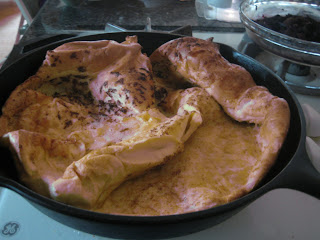We make a simple goat cheese daily. I call it Chevre, as that is what most people know as a fresh soft goat cheese. Technically, Chevre is poured into molds to drain, whereas I find it easier to pour the curds into cheesecloth to hang. Then I shape it into logs or pack it into jars. I find this to be the simplest and most versatile cheese to make. It does require direct set cultures and rennet which need to be special ordered from a Cheesemaking supplier. I use the Dairy Connection. I find their prices to be the most reasonable. I also order cheesecloths or butter muslin as the "cheesecloth" you'd buy at the supermarket is not the same thing and would not work for this purpose. The process is very simple. I find that the most tedious part of making cheese is packaging it and cleaning the cheesecloths. So without further adeu....
I should mention that I've used these first four pictures in a previous post on milking. I thought I'd include them again for those of you who are new readers. We are getting about a gallon and a half of milk per milking from three does. We were getting more milk from these does last summer. I've been somewhat puzzled by this. It is less milk than I'd thought we'd be getting, (hay quality?). Regardless, we milk the doe, weigh the milk, jot down the weight, pour the milk into a stainless steel lidded tote and when everyone is milked the tote and pail get carried into the house.


The milk gets poured into a stainless steel funnel with a disposable cloth filter, which helps filter out any hair or fine particles that may have fallen into the milk while milking. I usually filter the milk directly into the container I plan on storing the milk in. These days we pour the first gallon into a clean glass gallon jar. The rest goes into a half gallon or wide mouth quart jar to be used for drinking, yogurt or buttermilk.

A clean surface and clean utensils are important. My first summer I sanitized all my utensils, vessels and cheesecloth with bleach water. Then for a while I boiled the utensils to sanitize them. Now, when I make yogurt, feta, mozzarella or other labor intensive hard cheeses I would bring my cheese making pot to a boil with all the utensils inside and boil for ten minutes to sanitize. However, when I am making chevre daily I have not been sanitizing anything. I wash my utensils with soap and water, rinse with hot water and air dry. This is what I've been doing the past two years and haven't had any problems. I wipe down the counter and sink before I begin.
This recipe has originated from Molly's online Fiasco Farm Chevre recipe:
One gallon milk, about seventy to eighty degrees
1/8th tsp chevre culture, MM 100 or other
2 Tb. of rennet water (from 1 drop of rennet disolved in 5 Tb distilled water
kosher or other non-iodized salt
Add culture to milk, let dissolve while you prepare the rennet water, then stir. Add two tablespoons rennet water. Stir well and cover. Let sit twelve to twenty-four hours. Pour into two cheesecloths or cheese molds. Let drain. In cheesecloths it takes about seven to eight hours, but this does depend on house temperature and humidity. Molds usually drain for twenty-four hours.
I culture my milk as soon as we've strained it. It comes out of the goat the right temperature. Then I let it sit on on the counter all day and overnight. I pour it into cheesecloths in the morning, after it has sat for about twenty-four hours. The cultured milk is ready to hang by the evening before. However if I drain off the whey overnight the outside gets dry and rubbery. So, if you hang your cheese for too long the outside will get too dry and your finished product will have dry rubbery chunks in it.
Once the whey has stopped dripping from the cheesecloths, squeeze them briefly. Then dump the cheese into a bowl.
Add salt and stir or mash. I use a potato masher followed by a stiff rubber spatula. This is the time to add any other ingredients. Our favorite combination is fresh thyme, garlic and freshly ground pepper. We also add fresh chives and other herbs. The ideas are endless here; sundried tomatoes and basil, jalapenos, jam, honey, nuts, citrus peel...
I wrap the cheese up using plastic wrap. It makes nice logs which fit into a gallon ziploc nicely. Recently I've been packing and freezing cheese in eight ounce glass jars as well. Sometimes I weigh the cheese as I roll it up.
The cheese freezes beautifully. It keeps in the refrigerator for up to ten days. This cheese can be used as a substitute for drained cottage cheese or ricotta. We eat it with crackers, on sandwiches, in tacos, on scrambled eggs and in omelets and quiche. I make a cream sauce using chevre and goat milk for macaroni and cheese and pasta dishes. I love it crumbled on salads and pizza. Make a dip by drizzling with olive oil and warming gently. I add it to muffins, pancakes and breads. The other night instead of draining yogurt for a tzatziki sauce, I made it with chevre. The uses for this cheese are endless, which make it my favorite cheese to stock up on.
My least favorite part of the process is cleaning the cheesecloths. Boring and lots of hot water. There are always cheeecloths hanging to dry from our pots and pan rack.
And as I mentioned, the part I dislike the most is packaging it and cleaning the cheesecloths. It takes lots of hot water to get the cloths clean. There are always cheesecloths hanging from our pots and pan rack.




















































